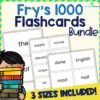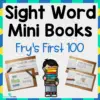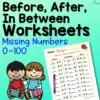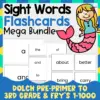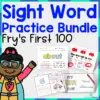Written in 1957 by Theodor Geisel, also known as Dr. Seuss’s, “Cat in the Hat” is a timeless tale about a mischievous cat in a striped top hat and a bow tie. Together with his companions, Thing One and Thing Two, they wreaked havoc inside a boy’s house and his sister, Sally.
With millions in copies, an adaptation in an animated version, and a live-action film, “Cat in the Hat” has become one of the most popular works of Dr. Seuss.
Here are 10 engaging activities inspired by this wonderful book.
Great Cat in the Hat Activities for Preschool
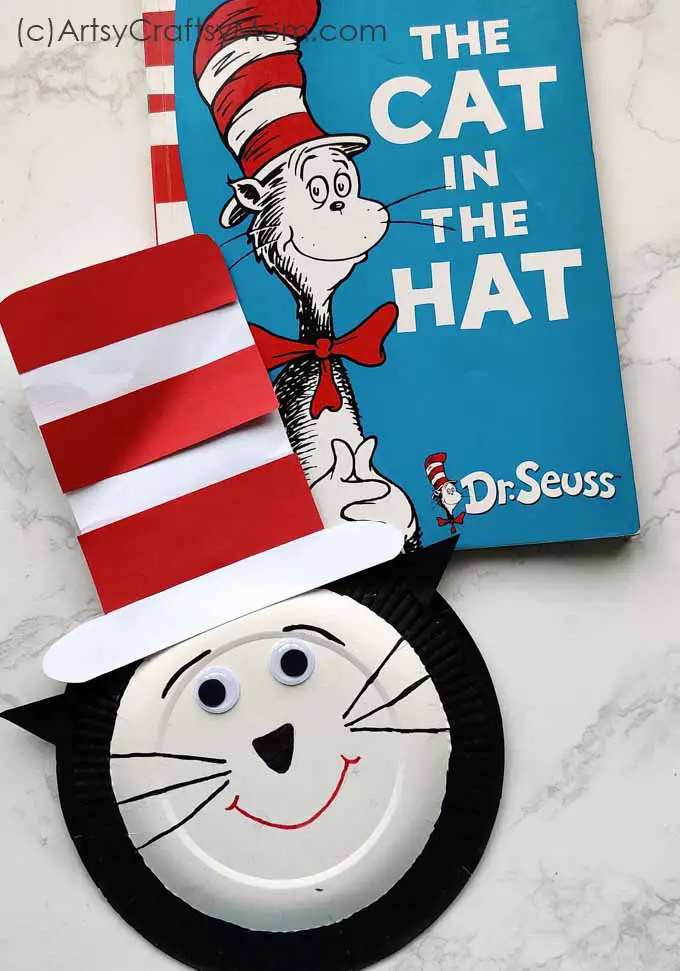
This cat craft is easy to make, even for young children. Children will have fun shading part of the paper plate black while improving their fine motor skills. They will cut some pieces of paper to make the striped top hat and the ears.
Start with cutting a white construction paper to make the hat. There is no template available, but this can be easily made by following the shape of the hat based on the pictures on the site. Cut red strips of paper and assemble the hat.
Next, flip the paper plate and use the black marker to shade the outer edge. Use the marker to create a line on the outer edge for young children as a guide. This way, they will not color beyond the line.
Use the black marker to add the triangle nose and whiskers. Add the mouth using the red marker. Lastly, glue the eyes and the top hat to complete the cat.
Extend this activity by making several cats. Change the position of their mouth to create different emotions, such as downward for sad, zigzag for mad, etc.
For this activity, you will need:
- Paper plate
- Googly eyes
- Construction papers
- Markers
- Scissors
- Glue
For more information on this activity, go to ArtsyCraftsyMom.com.
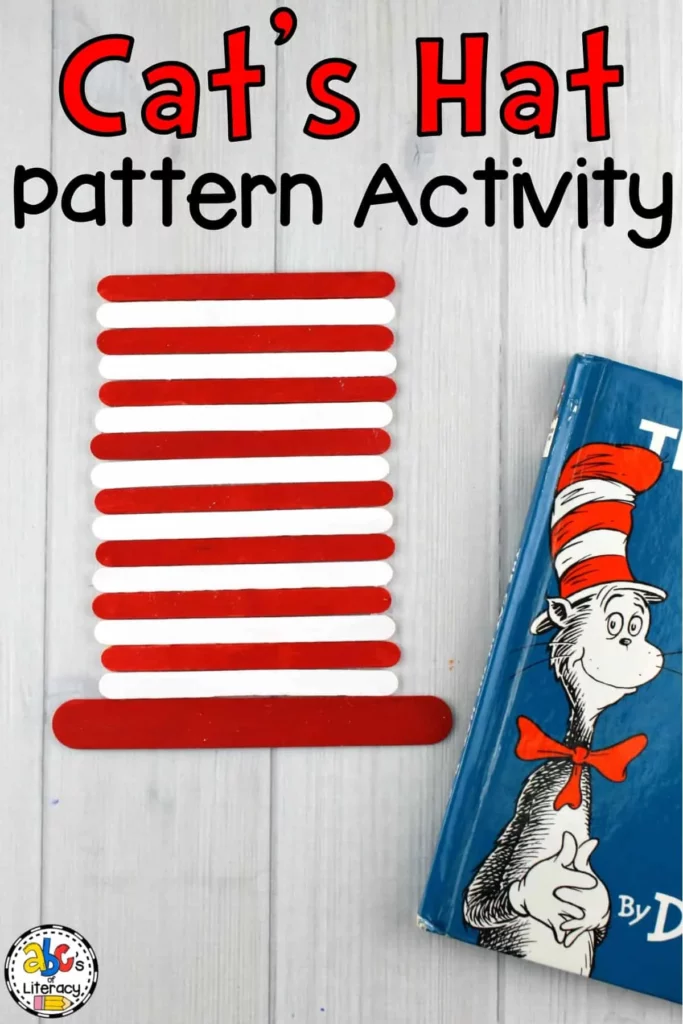
Learning patterns is a crucial math skill to learn during preschool. The cat’s hat is a perfect tool for teaching this skill to young children. Young learners will have fun arranging the colored craft sticks to change the stripes on the cat’s hat.
This pattern activity is excellent for Math centers, as a tabletop activity, or during one-on-one sessions. Keep the craft sticks in a container to make it easy for children to access.
Start with painting the craft sticks. Place an ample amount of red and white paint on the palette. Place the sticks on a newspaper or paint tray for a less messy workplace. Have the children paint one side of the craft sticks red and let them dry.
Next, flip the sticks over and paint them white. Allow the paint to dry before using. Next, show children how to arrange the sticks to make the hat by following a set pattern. Start with an easy pattern like ABAB, which is red-white-red-white.
Vary the pattern based on the child’s skills. The site suggests ABBABB, which is red-white-white-red-red, or AABAAB, which is red-red-white-red-red.
For this activity, you will need:
- One large craft stick
- Twelve regular craft sticks
- Red and white paint
- Paintbrush
- Small containers or palette
For more information on this activity, go to ABCsOfLiteracy.com.
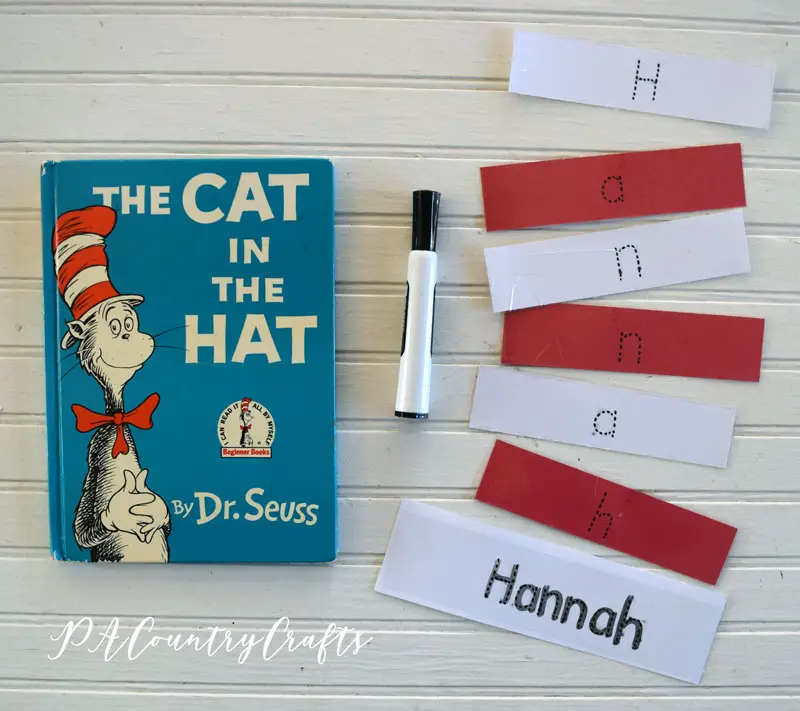
The cat’s hat is a versatile tool for teaching preschools different skills. In this activity, children will learn to write their names. Children will learn to recognize the letters in their names as they trace them on the strips of paper.
This cost-efficient teaching material is great for morning work or to take home for extra practice. Extend this activity by adding letters to trace to form decodable words found in the book.
For example, the book mentioned the words cat, hat, and pat for the -at family. Use the strips to blend sounds and, later on, recognize the words.
To make the name practice tracer, cut an equal size of red and white paper. Cut enough strips to form the child’s name. Cut a slightly longer strip for the hat’s brim. Use a fine marker to add the dotted letters on each strip.
Make the name tracer of the child on the hat’s brim using dotted letters. Next, carefully cover each strip with clear tape to make it reusable using dry-erase markers. An option is to laminate to make the pieces more sturdy.
For this activity, you will need:
- Red and white construction paper
- Black fine marker
- Clear tape
- Scissors
- Dry erase marker
For more information on this activity, go to PaCountryCrafts.com.
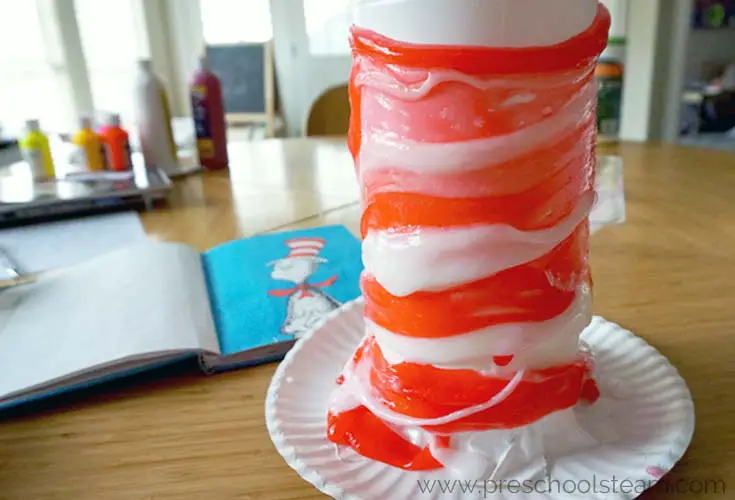
The cat’s striped top hat inspires this STEAM challenge. Challenge children by asking them if it’s possible to make the cat’s hat using the slime and the other available materials.
This science activity will garner a positive and excited response from young learners. They will have fun figuring out the possibility. Use the slime recipe provided on the site to create the red and white slime.
Provide prompts by showing what the plastic cylinder and paper plate look like when put together if the children cannot figure out what to make of them. Let them find the solution to problems, such as making the plastic cylinder stable on the paper plate.
Prepare the materials in advance for this activity or, if time is not an issue, have the children be involved as the slime is prepared.
Have the children put together the hat by sticking the plastic cylinder on the paper plate. Use duct tape to hold them in place. Allow children to alternately layer the red and white slime on the cylinder to create red and white stripes similar to the hat.
Extend the discussion by allowing children to explain their process of making the striped hat. Let them talk about which part was difficult and easy for them.
For this activity, you will need:
- Red and white slime
- White plastic cylinder
- White-coated paper plate
- Duck tape
For more information on this activity, go to PreschoolSteam.com.
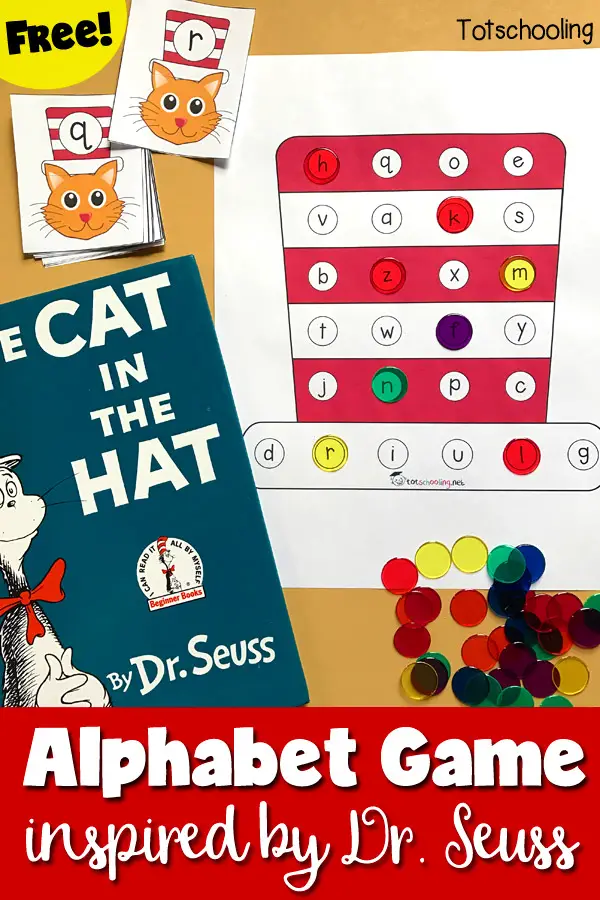
This alphabet game inspired by “The Cat in the Hat” will make learning letters a blast for children. This game comes in uppercase and lowercase letters to help children with their letter recognition skills.
Children will also learn patience and improve their scanning ability as they look for the matching letter on the mat.
Download and print the free alphabet game from the site. Cut out the pieces and prepare the counting chips. Shuffle the cards and lay them face down on a pile. Have the child take one card and find its matching letter on the hat-shaped letter mat.
Use the counting chips to cover the letter on the mat or dot markers. Repeat the process until all the letters on the mat are covered with counting chips.
Vary this activity by having two children play the game. Each will take turns drawing the card, and both will have to find the letter. Another variation is to use uppercase letter cards and lowercase mats or vice versa.
For this activity, you will need:
- Printed alphabet game
- Colored counting chips
- Dot markers
- Scissors
For more information on this activity, go to TotSchooling.net.
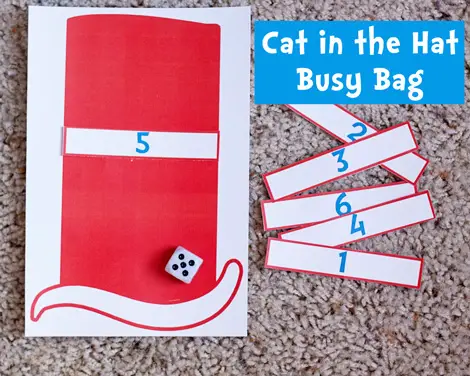
Use the cat’s striped hat to practice counting and learn numbers. Children will improve their Math skills through the different levels of the game. Make different variations of this game to extend this Math activity further.
Head to the site and download the free number game printable. Cut out the pieces and decide how to play the game. The site suggests three ways to play the game.
First, roll the die. Place the corresponding number of white strips on the red had based on the number shown on the die.
Second, write numbers one to six on the white strips of paper. Roll the die. Place the strip on the red hat with the corresponding number on the die.
Third, print several hats for a multiplayer game. Roll the die. Everyone races to place the correct number of white strips on the red hat based on the corresponding number on the die.
Here are other variations to this game. One, use this game to practice the concepts of many and few by comparing the number of white strips on each hat. Two, arrange the number in order from least to most or in reverse.
For this activity, you will need:
- Printed number game
- A die
- Scissors
For more information on this activity, go to SecondStoryWindow.typepad.com.
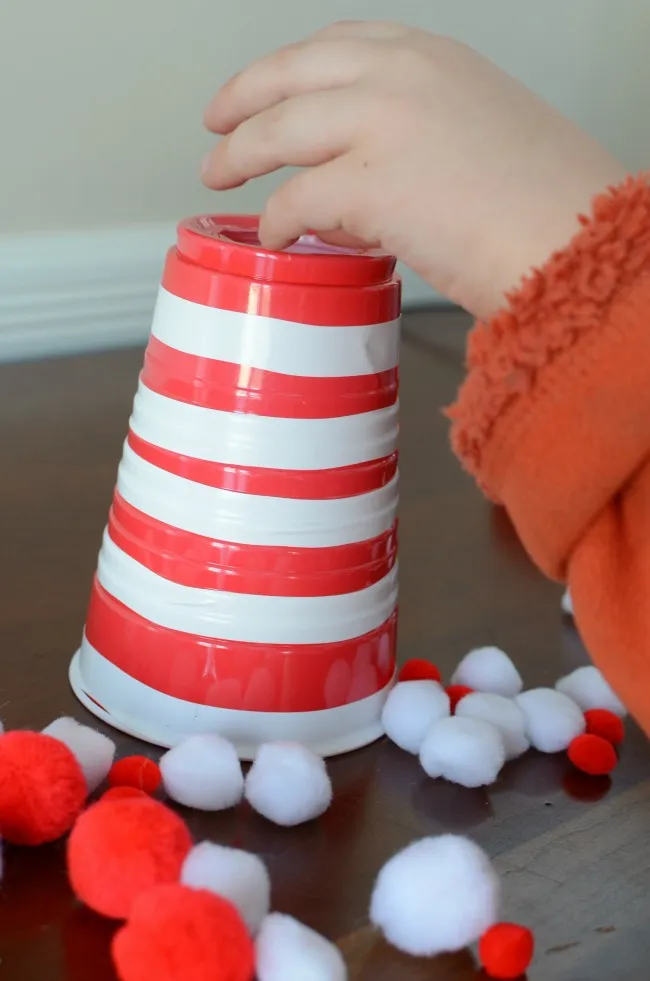
This fine motor activity turns a regular red plastic cup into the cat’s striped hat. Enliven any gathering by turning this game into the main event for the little “party animals” or use this activity in centers to improve the children’s three-finger grasp.
Start by flipping the plastic cup on a surface. Cut out a hole in the bottom part of the cup. Ensure that the edges are not sharp and will not cause scratches. Cut out several pieces of white tape and adhere them to the side of the cup.
Starting from the bottom, stick the first strip of white tape. Skip a space and add the second white strip of tape. Repeat the process until the cup resembles a striped top hat.
Here are the ways that this activity can be played based on the site’s recommendations. The first is to fill the striped hat with pompoms until nothing is left. Second, fill the hat with either one size or one pompom color. For this, make several striped hats.
Third, make this a multi-player game by having several cups for several children who will race to fill up their hats.
Fourth, use tools such as tweezers or clothespins to hold the pompoms as they are dropped into the hat. This helps develop fine motor skills.
Lastly, fill the hat with alternating colors of pompoms.
For this activity, you will need:
- Red plastic cups
- White tape
- Red and white pompoms
- Scissors
For more information on this activity, go to SimplePlayIdeas.com.
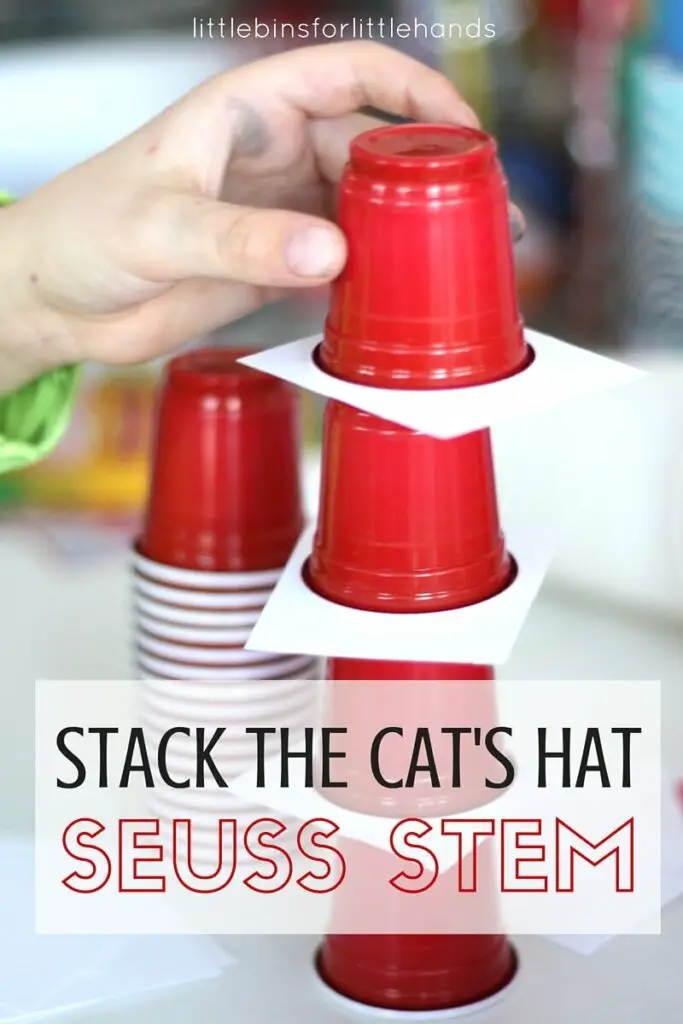
“Cat in the Hat” meets science in this fun game using cups. Let children enjoy and be competitive in this stacking activity. This STEM challenge poses the question: How tall can you make the cat’s hat?
While this is a science/STEM activity, it will also help children improve their eye-hand coordination by positioning the cups correctly so they can reach a good height.
Prepare all the materials beforehand. Cut squares from the construction paper. The squares should correspond to the size of the cups. Large cups will have large square papers. Each square should be slightly wider than the cup’s opening.
Next, lay all the materials on the table and deliver the challenge. Let children figure out the solution by suggesting to use all the materials on the table if they find it challenging to accomplish the task after many tries.
The site suggests allowing the trial and error experience for children for them to appreciate the process. Make this a multi-player challenge by having several children try to make the highest hat.
Children can also race to get this task done. Tally the scores and reward the winner.
For this activity, you will need:
- Red and white large and small cups
- Construction papers
- Scissors
For more information on this activity, go to LittleBinsForLittleHands.com.
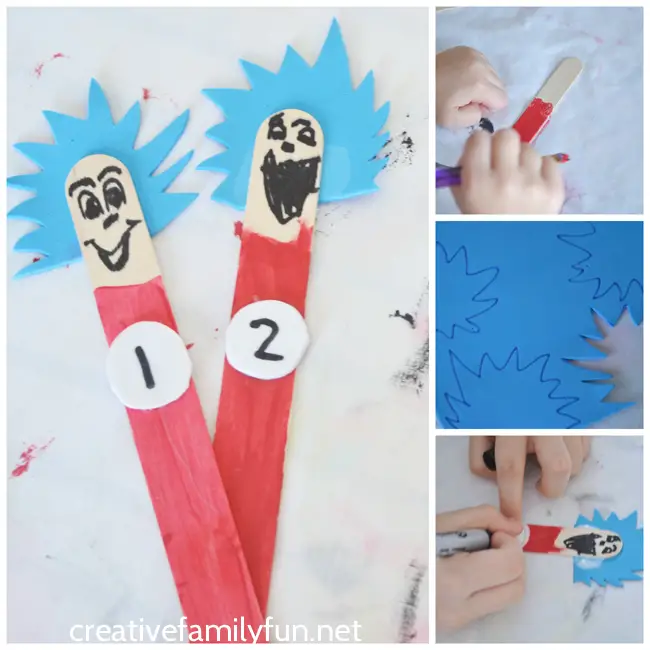
The infamous duo of the story takes the stage in this craft activity. Children will have fun painting, cutting, and assembling Thing One and Thing Two while improving their fine motor skills.
Have the children paint the craft sticks red. Leave enough space unpainted for the face part. Use the black marker to draw facial features such as eyes, a nose, and a mouth.
If possible, use a fine-tipped black marker to make the facial details more recognizable. Cut their funky hair from the blue craft foam. There is no template for this, but it can easily be drawn. Refer to the pictures on the site for this part.
Use a penny or small circle to trace onto the white craft foam. Use the black marker to write the numbers. Assemble them by using craft glue to adhere the hair and their number. Allow this to dry before using.
Use these to retell the story. You can also modify the facial expressions by changing the shape of the mouth to teach emotions.
For this activity, you will need:
- Large craft sticks
- Red paint
- Blue and white craft foam
- Scissors
- Craft glue
- Black marker
For more information on this activity, go to CreativeFamilyFun.net.
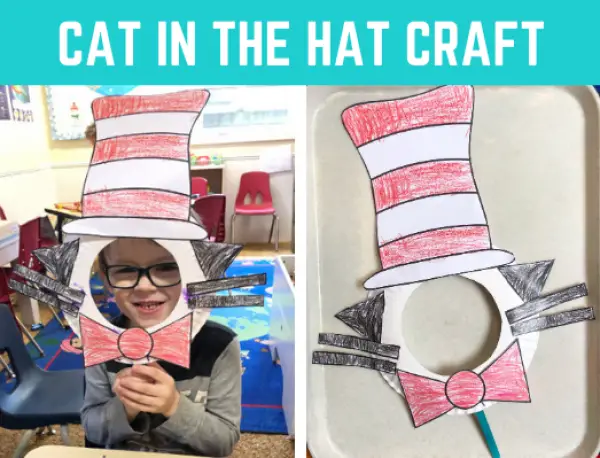
Children will enjoy making this easy craft that they can use to retell the story. Let them relive the story by using this craft. Modify this stick mask by punching holes on the sides of the paper plate and attaching rubber bands so it can be worn.
Cutting, coloring, and gluing the pieces together will improve children’s fine motor skills through this activity.
Download and print the Cat in the Hat template from the site. Have the children color and cut out the pieces. Refer to the pictures in the book for the right color to use.
Next, cut out a hole in the paper plate. Ensure that the hole is large enough for the child’s face. Assemble the craft by sticking the ears, whiskers, and bow on the paper plate. Refer to the pictures on the site for this step.
Glue the hat on top and let this dry. Attach the craft stick on the paper plate right behind the bow so that this craft can be held.
For this activity, you will need:
- Printed Cat in the Hat template
- Scissors
- Glue
- Crayons or markers
- Paper plate
- Craft stick
For more information on this activity, go to FunEarlyLearning.com.
Conclusion
We have listed ten varied activities inspired by the book “Cat in the Hat” by Dr. Seuss. These are all fun and exciting to make and do for children while they improve their skills.
Allow children to develop their imagination as they engage in activities that will challenge their thinking skills and creativity.
We hope you like our list. Thank you for reading!
For more activities, check these out:


